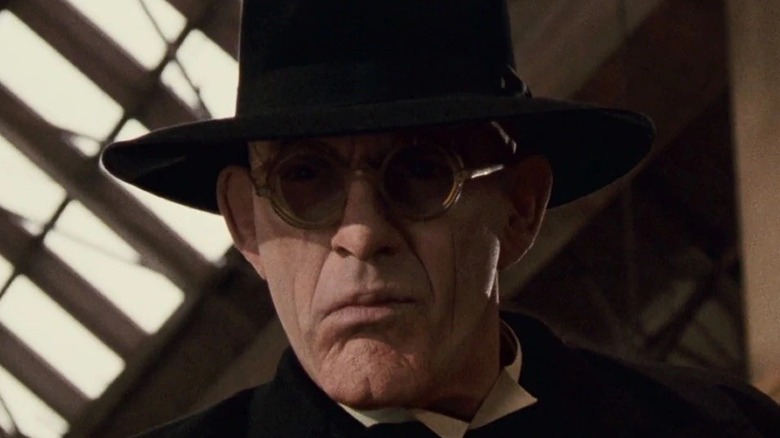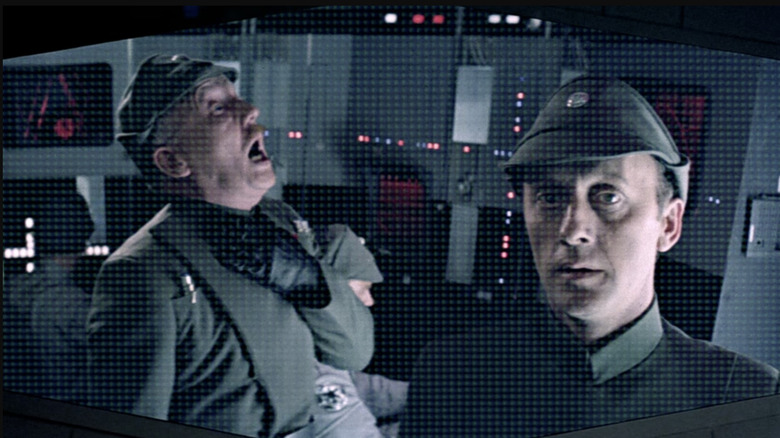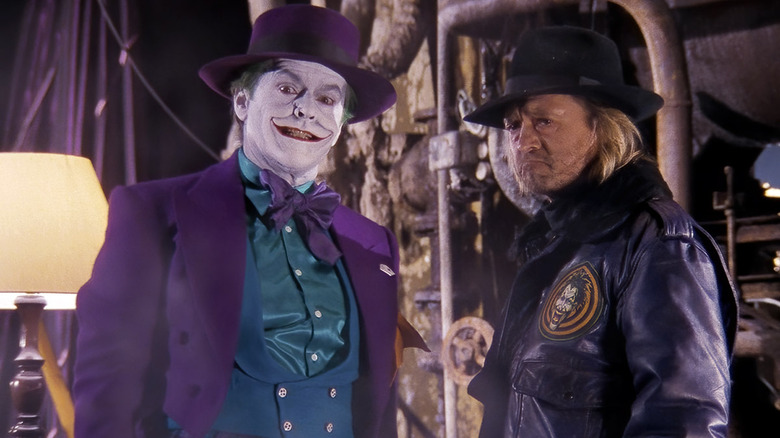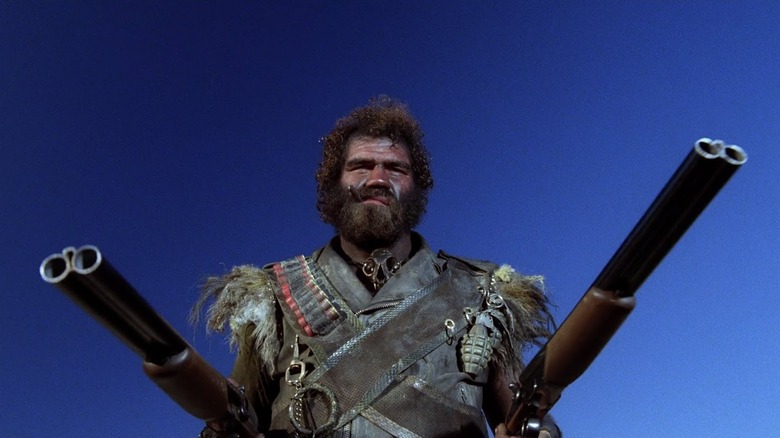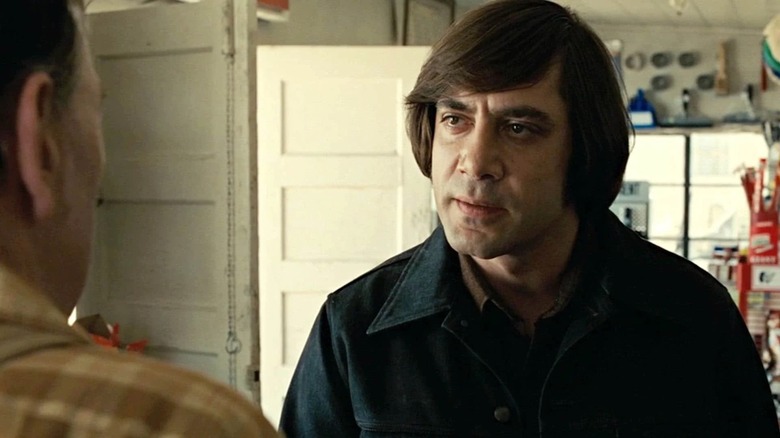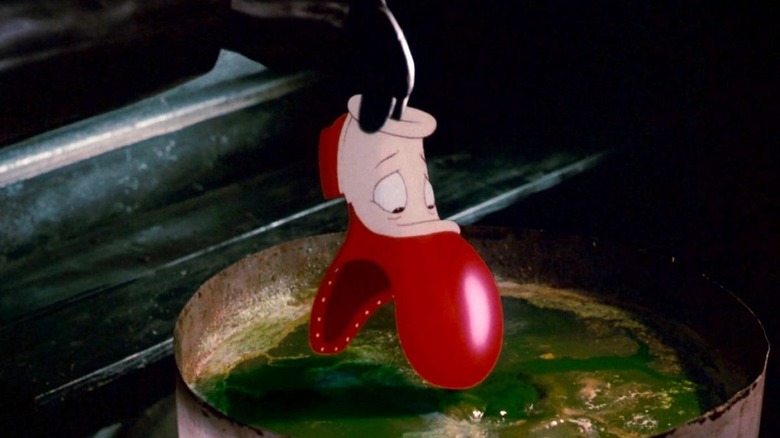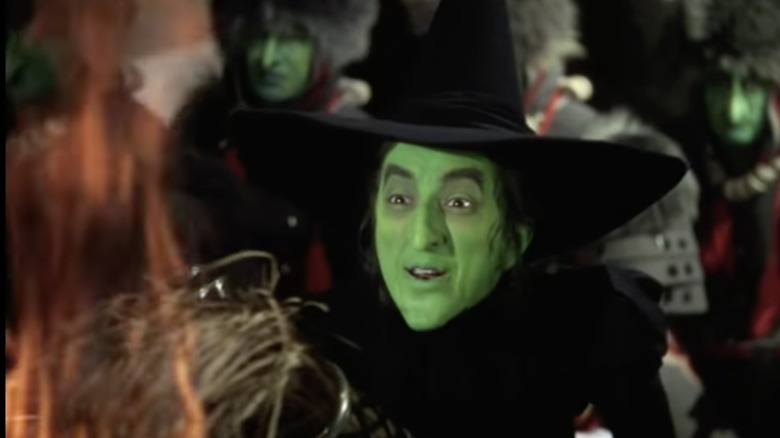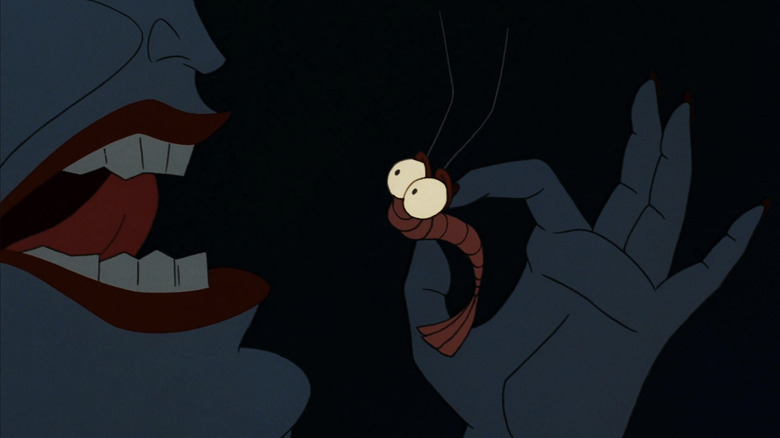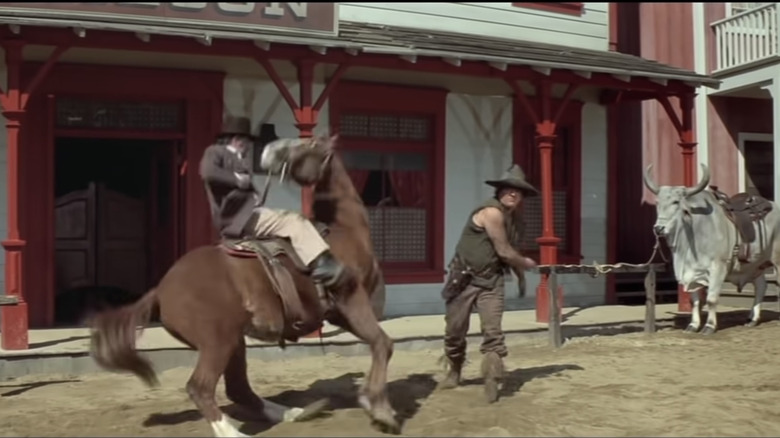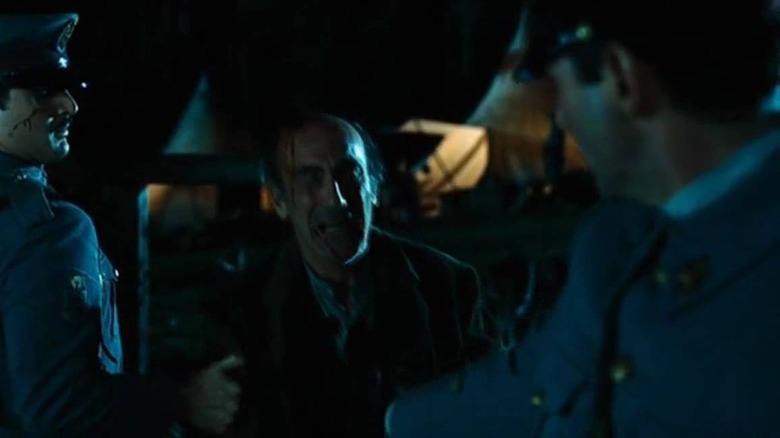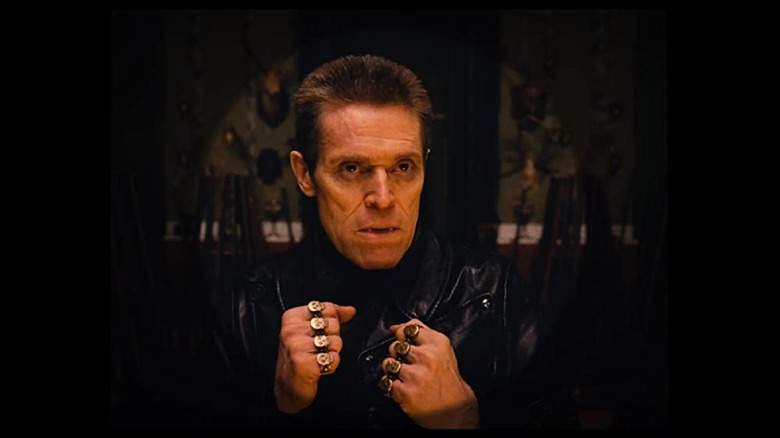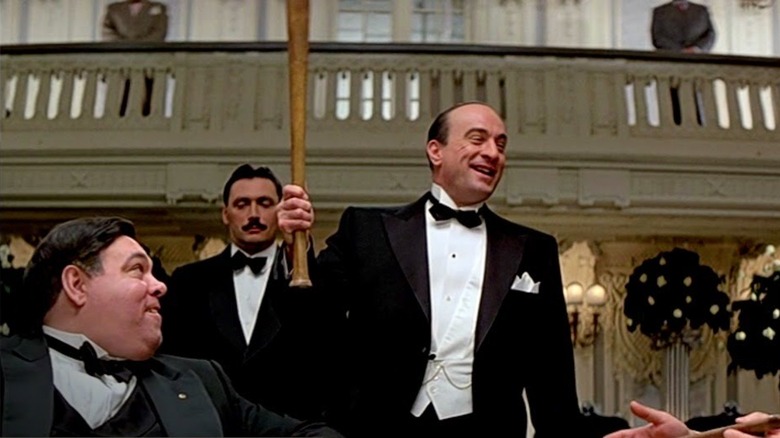Disturbing Scenes Where The Villain Was Deliberately Cruel For No Reason
In 2005, Blake Snyder published one of the bestselling screenwriting guides, named "Save the Cat!" after one of his central insights: if you want your audience to like your protagonist, introduce them doing something nice, like, for instance, saving a cat. Then came a corollary in "kick the dog." In this iteration, if you know someone's a hero because they do something nice, you'll know someone else is the villain because they do something evil — usually for no reason except because it's evil.
While the latter trope got its name from an Alfred Hitchcock quote disparaging the cartoonishly obvious villains of past decades, when it's done right, these moments of gratuitous cruelty can make a villain unforgettable. If they'll do something so horrible to some guy on the street, or even one of their loyal followers, what hope do our heroes have? (Of course, this creates its own set of problems since they seem to kill everybody but the heroes.) From cartoon villains munching on adorable fish to atrocities by representatives of real-world regimes, here are some of the nastiest moments of needless villain cruelty.
This article contains spoilers.
Darth Vader chokes his way through his staff
The first time we see Darth Vader in "Star Wars," he's choking a man to death without even touching him. Like any good sequel, "The Empire Strikes Back" goes even bigger. First, we learn he doesn't even need to be in the same room with someone to murder him. After one of his admirals accidentally alerts the Rebels to the incoming attack on their arctic base on Hoth, Vader takes him out over video chat. His last words to the admiral are so classic they became shorthand for this kind of villain-on-villain violence: "You have failed me for the last time."
Vader is even more cold-blooded the next time one of his officials fails to live up to his high standards. After General Needa loses the Millennium Falcon, he agrees to take the fall for his men and apologize, no doubt knowing what's about to happen. The next we see him, he's collapsing dead at Vader's feet while the Sith Master gloats, "Apology accepted."
In a lesser movie, these scenes would have still been badass but would have felt hollow when he let the heroes get away scot-free. Not in "Empire" — he's just as committed to offing his enemies as his allies, freezing Han Solo with no guarantee he'll still be alive when he's thawed and challenging Luke to a duel that the Jedi apprentice literally doesn't escape in one piece, losing a hand in the battle.
Bob, gun
When Tim Burton's "Batman" debuted in 1989, the Joker's biggest pop culture footprint was in the comedy-oriented TV show of the '60s and a variety of kid-friendly cartoons and toys. In all of them, he was little more than a harmless prankster. So it must have been a shock to contemporary audiences to see Burton and Jack Nicholson jerk the Joker so violently back to his murderous comic book roots.
The Joker spends most of the movie killing the people of Gotham more or less at random with his "Smylex" concoction, leaving their corpses with horrible rictus grins. His body count must number somewhere in the high double digits by movie's end, but none of that's quite as shocking — or hilarious — as how he treats his own gang. After Batman ruins his plan to take out the whole town with a parade's worth of gas-filled balloons, the Joker has a lot of anger to vent. After ranting at Batman for a little while, he seems to have gotten it out of his system based on how calmly he tells his "number one guy," "Bob, gun." Bob obliges, and the Joker shoots him dead in the chest without so much as a blink. This is what happens when you get a job with a homicidal maniac, folks.
Some men just want to watch the world burn
One of the reasons Heath Ledger's interpretation of the Joker in "The Dark Knight" has become definitive to so many fans is only the clown himself knows what motivates his crimes. With that in mind, nearly anything he does could qualify for this list. As Michael Caine's much-quoted monologue says, "Some men just want to watch the world burn." The mob learns this the hard way every time they try to negotiate with him, which tends to end either with one of them getting a pencil rammed in his forehead or two of them watching their boss die and having to fight to the death for continued employment under the Joker. Even when the mob tries to buy him off with a literal mountain of money, he sets it on fire and feeds a high-ranking boss to his own dogs.
And that's just the start of the scenes that make the Joker eligible for this list. Before we even see his face, he's setting his own gang on each other just so he won't have to divide the take from their bank robbery. Later, we see his master plan of pure sadism, forcing the occupants of a transit and prison ferry to decide whether to kill each other or wait for him to kill them all.
Bunny, meet grenade
The Coen Brothers have delighted fans by developing their personal repertoire of themes and types throughout their careers. A big favorite in the Coen Stock Company is the stoic, unstoppable bad guy — Gaear Grimsrud in "Fargo," the Sheriff in "O Brother, Where Art Thou?" and of course, Anton Chigurh in "No Country for Old Men," who we'll be seeing again soon. And all these characters can trace their family tree to the ironically named Leonard Smalls in the Coens' second film, "Raising Arizona."
That comedy classic featured a young Nicolas Cage as a small-time convenience-store robber and serial recidivist H.I. McDonough. He gets dragged back into his life of crime by, of all people, Holly Hunter as his police-photographer wife. Depressed by their inability to conceive, she learns that the wealthy Arizona family just had quintuplets and, since "they have too many to handle," no one will care. They turn out to be very wrong, as H.I. learns in a dream that night of Small tearing down the highway in a wave of fire. Then he takes one of the many hand grenades he's got strapped to his vest and tosses it to a rabbit at the side of the road. Why? Because he's just that evil, and on this list, you don't need a better reason.
What's the most you've ever lost on a coin toss?
As cartel hitman Anton Chigurh in "No Country for Old Men," Javier Bardem created one of the most memorable faces of evil in modern movies — it was almost inevitable when he was cast as a Bond villain a few years later. We first get a glance at him in the back of a police car, but by the time we see his face, he's already strangled his arresting officer to death with the cuffs that were supposed to keep him harmless. He rides off in the cop car and uses his borrowed authority to pull over a random driver and shoot him straight through the forehead with a slaughterhouse bolt gun.
But for all the murders Chigurh commits, it's the one he stops short of finishing that's haunted audiences the most. As he gases up his stolen car, Chigurh gets progressively more annoyed at the station attendant's vapid small talk, his lame excuses to cut the conversation short, and finally, the discovery he married into his business, when you can see Bardem's face subtly turn murderous. He sees a man who never had to risk anything to find success, and he turns that against him, venomously asking, "What's the most you ever lost on a coin toss?" He never explicitly answers the man's question, "What do I stand to gain?" except to say, "Everything." But we in the audience know just how close the station attendant came to a grisly death just for wasting the time of a man with no time to lose.
Judge Doom melts shoe, scars kids
These are all classic examples, but there's one that's been burned into the brains of all movie fans of a certain age — and no doubt beyond, given the movie's timeless appeal. For many of us, it was our first real experience with movie horror — and the fact all this abject terror centers around a goofy little clown shoe with a cute voice only makes it worse.
In "Who Framed Roger Rabbit?" the death of novelty mogul Marvin Acme attracts the attention of Christopher Lloyd as Judge Doom, who got his position on a campaign of bringing order to the chaotic district of Toontown. This means introducing capital punishment to the neighborhood's indestructible population of living cartoon characters, and, thanks to a concoction he simply calls "dip," that's what he plans to do.
He's not shy about demonstrating how he'll do it, either. In the investigation, the cops accidentally spill a crate of living shoes, one of whom makes the mistake of nuzzling Doom's foot like an affectionate dog. Untouched, Doom only sees an opportunity to road-test the dip, and he liquifies the poor shoe, apparently unperturbed by its bloodcurdling screams. It only gets more unsettling when Doom pulls his gloved hands out of the vat, covered in red ink that might as well be fresh blood.
The last to go will see the first three go before her
Inspired by the blockbuster success of Walt Disney's first feature, MGM launched their own fantasy epic, starring Margaret Hamilton as a witch that would send Snow White's stepmother running screaming for the hills. The Wicked Witch of the West discovers Dorothy accidentally squashed her sister, the Witch of the East, when a cyclone dropped her house in the land of Oz. The surviving witch is less interested in mourning than grabbing her sister's magic ruby slippers, but she discovers they've been mystically transferred to Dorothy.
The Witch almost seems to prefer this outcome to simply taking the slippers because she spends the rest of the movie mercilessly tormenting Dorothy and her friends. The Witch finally locks Dorothy in her dungeon with an hourglass counting how long she has to live before the Witch prepares the spell to detach her from the slippers. The Witch tortures Dorothy by showing her Auntie Em worrying if she'll ever come home before replacing Auntie Em's face with her own and throwing Dorothy's sobbed-out words back at her like a schoolyard bully.
When Dorothy's friends infiltrate the Witch's castle and it seems like everything's going to be okay, the Witch twists the knife even further. She locks the door just as they're about to escape and promises "The last to go will see the first three go before her" — and since all Dorothy's companions are male, there's no doubt who "her" could refer to. Her first target is the flammable Scarecrow, and call it karma that when Dorothy tries to put him out she splashes water on the Witch, "meltiiiiiiiing" her.
Ursula's adorable snacks
With "The Little Mermaid," Walt Disney Animation shook off the string of low-risk, low-yield movies that had followed Disney's death with a bona fide Disney musical extravaganza. That meant reintroducing the world to the joys of the Disney villain, and the studio put their best foot forward when they introduced Ursula the Sea Witch. Following her into her lair deep in the bones of some long-dead sea monster, we meet Ursula after the movie has already introduced us to a kingdom of cute, almost-human fish. And then we see one of the cutest of them all, a little shrimp with eyes any Keane kid would envy — just in time for Ursula to toss it into her mouth. The shrimp lets out a high-pitched scream as Ursula noisily crunches it between her teeth. For extra nastiness, the whole scene is framed to shrimp scale — all we see of Ursula is her gigantic mouth, making sure we see ourselves as the shrimp just before it turns into witch food.
It's a classic introduction, and this gratuitous evil makes Ursula perversely more likable rather than less. She's not a tormented antihero — she loves being evil, and that enjoyment is infectious, making Ursula one of the movie's standout characters, and possibly one of the most popular Disney ever created.
Mongo, the horsepuncher
Dog-kicking is already so over-the-top that it's ripe for parody, and director Mel Brooks never saw a movie cliché he couldn't skewer. So in "Blazing Saddles," when robber baron Hedley Lamarr can't get the town of Rock Ridge's bigots to turn on their new sheriff "Black" Bart and sell out fast enough, he decides to send in the big guns to intimidate the villagers.
That would be Mongo, a hired thug so huge and terrifying he sends everybody for cover just by riding into town on his huge Brahma bull. How bad is he? Well, when an old man complains about him hitching his bull in front of the bar, Mongo decks his horse right in the face, knocking animal and rider clean over. Maybe he just resents horses since he could never find one big enough for him. But even a horse puncher isn't totally beyond redemption, and Black Bart quickly gets Mongo to join him in saving the town from his former boss. After all, as he puts it, "Mongo only pawn in game of life."
The hunters and the wine bottle
We've tried to keep it light here by focusing mostly on genre films with over-the-top bad guys. After all, this is just a dramatic convention — no one in real life would do something this evil just to convince his audience he is evil, right? Well, while the reasons might be different, the sad fact is that this kind of cruelty does exist. Sometimes it intrudes into our cinematic fantasies, but rarely as chillingly as it does in "Pan's Labyrinth."
In "Pan's Labyrinth," horror master Guillermo Del Toro conjures up all kinds of grotesque monsters, from the titular faun to the nightmarish Pale Man. And yet none of that compares to the real-world terror of then-fascist Spain. Running parallel to the fairy-tale story of young Ofelia discovering she's a secret princess of the underworld is the people's struggle against her new father, Capitan Vidal. Fittingly for a fairy tale, he's a true evil stepfather, but the level of evil goes beyond what most storybooks would allow. Not long after we meet Vidal, his soldiers bring him an old man with a gun they suspect of supporting the rebels. The old man insists he was just hunting rabbits for his sick daughters as Vidal searches his bag. Finding a wine bottle, he beats the hunter's son with it until his skull caves in and shoots the old man. When Vidal finishes searching the old man's bag and discovers he really was hunting rabbits, the closest thing he can come up with to remorse is to snap at his men to "search these a******s properly before you waste my time."
Did he just throw my cat out the window?
Willem Dafoe worked with director Wes Anderson before he joined the all-star cast of "The Grand Budapest Hotel," but even the knife-wielding literal cartoon rat Dafoe voiced in "The Fantastic Mr. Fox" isn't half as nasty as Jopling, the ruthless assassin he plays in "Budapest."
In the film, Ralph Fiennes stars as M. Gustave, the titular hotel's concierge, whose affair with a rich widow (Tilda Swinton) ends with her willing him a priceless Renaissance painting. Her son Dmitri (Adrien Brody) doesn't take this well at all, and he has Gustave arrested for his mother's murder. Jeff Goldblum appears as Dmitiri's lawyer, Kovacs, who begins to suspect foul play and the existence of a second will. Dmitri doesn't like this either. After trying to intimidate Kovacs into silence, he leaves, while Jopling, who has been standing in the background stroking a cat the whole time, tosses it out the window without his grim expression changing one bit. "Did he just toss my cat out the window?" the lawyer asks. In a situation like that, what else can you say?
If you think that's a dry, dark joke, it's nothing compared to the punchline, where Kovacs retrieves a coat check card that lists "One cat, deceased." After all that, it's hardly a surprise when Jopling murders Kovacs, even if the brutality of it — cutting Kovac's fingers off with a door — might catch you off guard.
Al Capone steps up to bat
When you see a gangster waving a baseball bat around, it's normally pretty clear where the scene is going. However, "The Untouchables" establishes Robert De Niro's Al Capone as a different kind of gangster. He's introduced in his palatial hotel suite with a British reporter asking if he could be considered the true mayor of Chicago. While he's indirectly responsible for unimaginable violence, Capone mostly conducts himself like any other businessman. We don't see him really lose his cool until Elliot Ness (Kevin Costner) and his crew successfully raid one of his bootlegging operations in the Chicago Post Office.
At first, he seems as businesslike as ever, attending a white-tie dinner and using the bat as a visual aid to give his organization a pep talk about his love of the sport and the importance of teamwork. Then his visual aid gets a little more visceral as he takes that bat to one of his lieutenants until he collapses in a puddle of blood big enough to use a placemat.
"The Untouchables" gets its name from a Capone-affiliated alderman who mockingly throws it at Ness for refusing to take a bribe, but since Capone clubs a man to death in front of a table full of Chicago's business elite and walks away as if nothing happened, who's really untouchable here?
